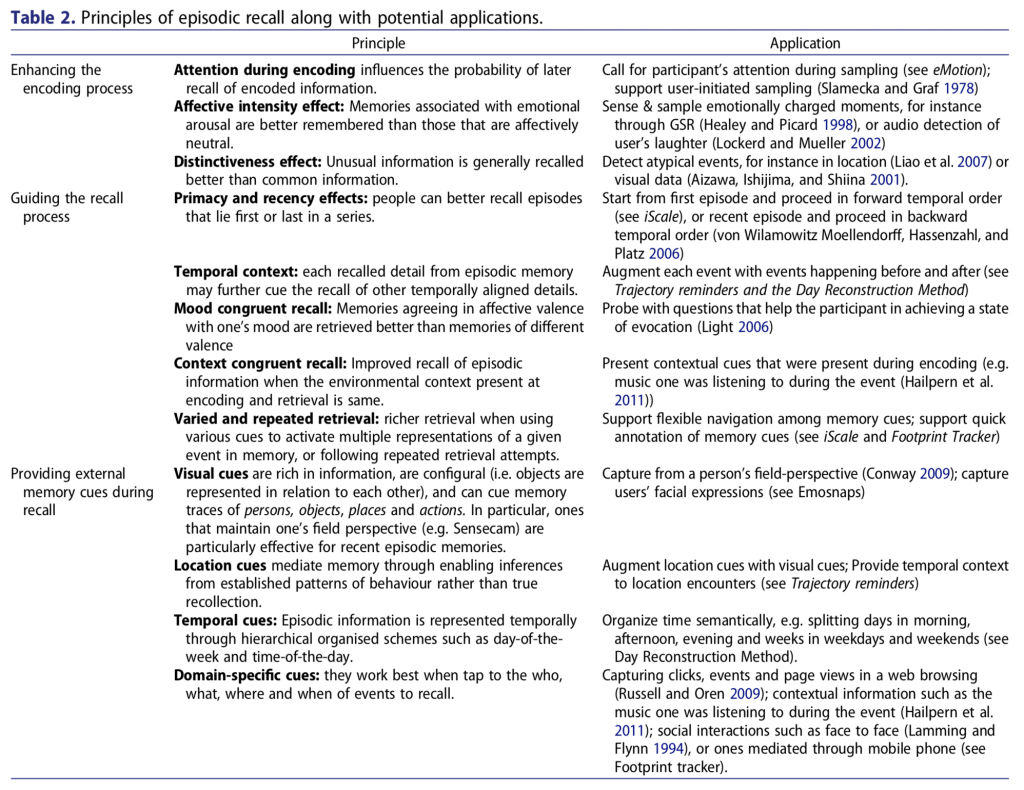We recently published an article summarizing our work and our vision for a methodological paradigm we call Technology-Assisted Reconstruction. You may be asking: what is Technology-Assisted Reconstruction?
Suppose you want to measure how people feel, or what people do throughout the day. In Human-Computer Interaction (HCI), you may be interested to study how a novel communication system affects feelings of connectedness among family members, or how a self-tracking technology affects users’ motivation for, say, physical exercise. How do you go about it?
One approach is to ask people at the end of the day to recall episodes where they interacted with the system and recount how they felt and what they did during those episodes, or to ask them to provide “global reports” on how they system affects their feelings of connectedness or their motivation for physical activity, overall. Such retrospective judgments suffer from recall and social biases.
Another alternative is to employ the Experience Sampling Method (ESM), which consists of prompting the user with short questionnaires, at random, or otherwise-defined times throughout the day. With the widespread adoption of sensor-filled mobile technologies, we can now schedule such prompts rather effectively. For instance, we can ask people to report how motivated they feel, right after they interact with the self-tracking technology, thus being able to study the proximal impact of feedback on individuals’ motivation. ESM minimizes recall and social biases and is considered to be the gold standard of momentary assessment.
One challenge with ESM, is that it imposes a high burden on participants due to the repetitive interruptions. Daniel Kahnneman and colleagues published an article in Science in 2004 on an alternative to ESM, the Day Reconstruction Method (DRM). DRM does not interrupt participants throughout the day but rather asks participants, at the beginning of the next day, to list their daily activities as a continuous series of episodes. This is assumed to minimize recall bias through increasing the number of cues to episodic memory people have access to, and which they use to infer experiential information. DRM has been found to provide a reasonably good approximation to experience sampling data and the method has been well adopted by the HCI community.
With Technology-Assisted Reconstruction we argue that our field has the capacity to contribute towards a next step in the field of momentary assessment, where passively logged data from sensor-based technologies, such as the locations we visit, the social interaction we perform through technology, and what we see, as captured from lifelogging cameras, can be leveraged to support recall. This article attempts to make three contributions:
- It reviews the use of ESM and DRM in HCI literature and discusses the challenges researchers have encountered.
- It presents our vision on Technology-Assisted Reconstruction and illustrates this, through five different methods we have developed over the past ten years.
- It proposes a framework for the development of TAR methods (see table 2), which summarizes three distinct strategies: (a) enhancing the encoding process as the event takes place, (b) guiding the recall process, and (c) providing external memory cues during recall.
| Karapanos, E. (2019): Technology-assisted reconstruction: a new alternative to the experience sampling method, Behaviour & Information Technology, DOI: 10.1080/0144929X.2019.1608303 |

